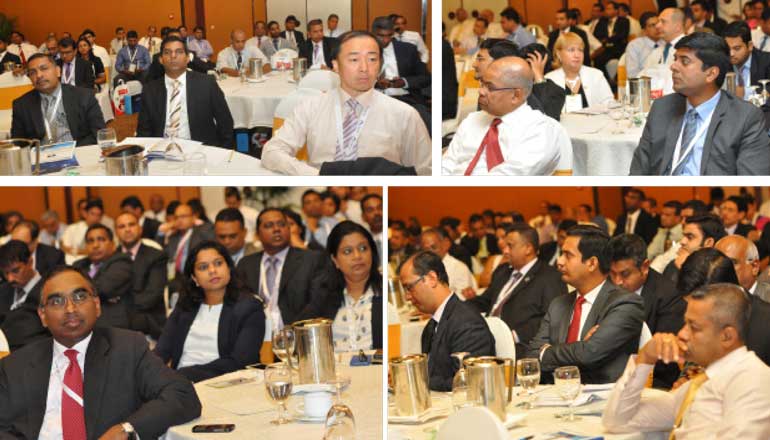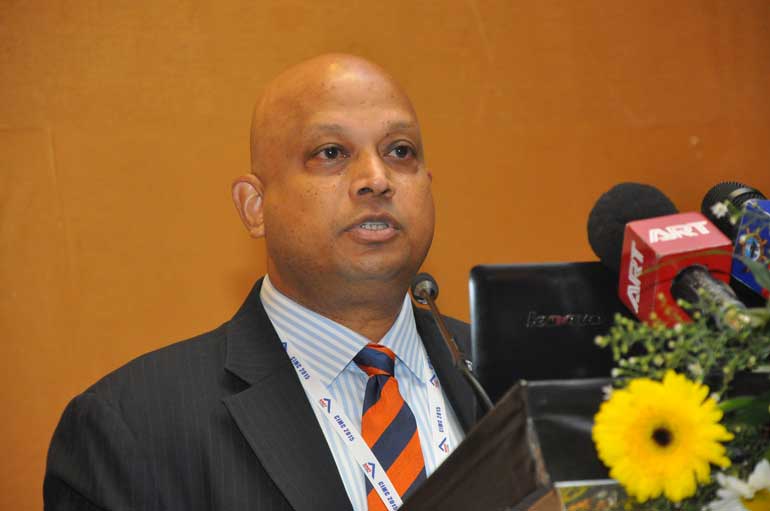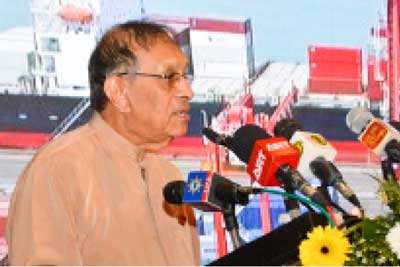Friday Jan 10, 2025
Friday Jan 10, 2025
Thursday, 1 October 2015 00:00 - - {{hitsCtrl.values.hits}}

From left: South Asia Gateway Terminal Chief Commercial Officer Ted Muttiah, Sri Lanka Ports Authority Director Operations Upali De Zoysa, South Asia Gateway Terminal CEO Erwin Haaze, Ravindra Galhena, Aitkin Spence Shipping Chairman/CEO Dr Parakrama Dissanayake, Colombo International Container Terminals General Manager Tissa Wickramasinghe
By Madushka Balasuriya
The inaugural Colombo International Maritime Conference (CIMC) concluded on Saturday, with several key topics pertaining to the South Asian maritime industry discussed over the course of the three-day conference.
Ninety per cent of the world’s trade is moved through shipping, and with Sri Lanka poised to play a major role in the coming decades to service the Indian Subcontinent and Asia as a mega transhipment hub, the overarching theme of the conference was Sri Lanka’s role in maritime development as a regional hub.
“The Sri Lanka Port Authority has been very astute in developing a port that continues to stay relevant to container shipping trends. In 2014 the Port of Colombo recorded the second biggest year-over-year percentage growth in the top 30 ports in the world,” noted South Asia Gateway Terminal (SAGT) Chief Commercial Officer Ted Muttiah, addressing the opening session of the conference.
A major portion of the traffic handled by the Port of Colombo is down to India. India is both the number one port of destination for transhipments moving out of Colombo, and the number one port of origin for transhipments coming in the port.
“It is no secret, the Port of Colombo’s fortunes are closely linked to India’s growth aspirations,” acknowledged Muttiah.
Indeed, India-Sri Lanka trade in 2014 was above $ 4.6 billion, and with the trade in the first half of 2015 valued at $ 2.6 billion, Muttiah believes the full year 2015 outlook is set for a new benchmark.
However, he feels even more trade is possible between the two neighbours; India’s east coast ports contribute more with regards to transhipment over Colombo than the west coast ports. With India’s west coast ports facing challenges over congestion, Muttiah feels there could be a mutually beneficial solution at hand for the two nations.
“The potential for Colombo to play an increased role in alleviating the challenges faced by the Indian west coast ports is evident here. West coast India represents about 30% of Indian cargo moving over Colombo. I believe an increase in frequency of services 2000-4000 TEUs every day between Indian west coast ports and the Port of Colombo can deliver better outcomes than several big ships dumping big volumes on a weekly basis.
“The port of Colombo is complimentary to India’s growth aspirations. To attract the biggest vessels with increased frequency in to Colombo we need carriers to think and rethink shipping networks so that Colombo can expand its current volume in the catchment area. Clearly an increased frequency sailing from west coast Indian ports to Colombo will provide this much need increase in volume exchange to attract the bigger ships.”
However he notes that as evermore larger ships make their way through the east-west trading route, this will see a reduction in the number of ships a terminal will be able to hold. This problem though can be circumvented with the use of the Colombo Port which will be beneficial to both parties.
“We as the so-called captains of industry here in Sri Lanka and those of you visiting from India cannot allow future growth to be impeded, and lose the momentum or opportunity for India to realise its fullest potential. In so doing the Port of Colombo will surely emerge so much stronger positioned in terms of its relevance as a maritime hub. In the process also improving the two countries’ economic fundamentals.”
While the fortunes of India and Sri Lanka are inextricably linked, there were discerning voices of caution at the prospect of putting all of Sri Lanka’s eggs in the Indian basket. One such voice was Regional Manager of CMA Terminals in Asia Sarath Kumara Premachandra, who said that while India accounts for a large portion of Colombo’s throughput, Colombo by comparison is only a fraction of India’s total traffic.
“India accounts for 75% of Colombo’s transhipment throughput, not traffic, throughput. When you compare India’s gateway traffic with Colombo’s Indian-related inbound traffic, it’s a different picture. This represents only 12% of Indian gateway throughput,” he explained, in his address which focused on emerging new hubs in South India.
A solution however may be at hand; the Port of Colombo shares a hub concept similar to that found in Singapore and Dubai, and while not in the same scale, Colombo does present its customers with the option of three terminals which the other two cannot offer.
“Look at the market which is dwindling and the capacity which is increasing. There is a gap which is widening between these two and unless volumes radically increase, the three terminals operators will find it difficult to survive together. The weakest terminal will lose, while the others will gain. Overall Colombo will not gain as a result, so Colombo needs to aim at new markets in the future.
“Colombo can meet its demand, but only if its three operators pool their resources. If we have a good connectivity system and infrastructure, and the tools to control this, it doesn’t really matter where the ship berths. It matters how you manage it, and of course when you have one terminal, one guy in a competition with his hands tied behind and two other guys challenging him to a fight, it’s an unequal fight. Only when there is level playing field can you say there is fair competition in this port,” warned Premachandra, who has wide experience in working with a multitude of ports in many countries on Terminal investment and efficiency enhancement on behalf of CMA CGM.
Capacity trap
Another topic that received notable coverage at CIMC 2015 was the issue of ‘capacity traps’. In layman’s terms this refers to demand not meeting supply. Chairman/CEO Aitken Spence Shipping Parakrama Dissanayake had a more in-depth analysis.
“Are we walking in to a capacity trap? Now, if you look at the current capacity of the Port of Colombo, it’s eight million TEU capacity. We have a design capacity plan of 16.4 million TEU and the demand this year will only be 5.2 million TEU. So when this goes on, they take a loan and they construct the second phase of Hambantota. I believe they are spending around 1 billion USD to construct a new container terminal, which stands side by side with TEU capacity in Colombo. So are we not, ladies and gentleman, walking in to a capacity trap?” asked Dissanayake, who is also the Joint Managing Director of CINEC Maritime Campus.
“I’m sure CICT must be concerned. I’m sure JCT must be concerned and I’m sure SAGT also must be concerned. When you have surplus capacity what happens? It destroys existing capacity, and also the planned capacity.”
This problem however is not exclusive to Sri Lanka and the South Asian region, it is also a problem plaguing the international maritime industry.
“The international scene is not great, and it hasn’t been for a while. There are more boats than there is cargo,” offered Julian Bevis.
Importance of cooperation
Bevis, who is the South Asia Group Director of Maersk Line India, in his speech primarily focused on providing an international perspective on the Indian ports and shipping industry. While he rarely spoke of Sri Lanka directly, several lessons were on offer for Sri Lankans listening in.
“In India the Government is confused by the disparity of views being expressed in the transports sector. There are all sorts of people arguing my view very emotionally and parochially and not really thinking about what lies behind the issues they’re talking about. This [shipping] is a collective issue, it has to be approached collectively and I think the industry needs to work together much more closely and much more coherently. If I was a policy maker the cacophony of opinions and noise would confuse me thoroughly.”
Despite his call for cohesive policy, Bevis also urged governments to avoid feeling the need to take regulatory action.
“We have to try and restrain the tendency there is to reach for the regulatory lever every time there is an issue. The best regulator of all is the market place. If you give people a choice, then hopefully markets will operate; that’s the best regulator.
“Obviously if we are going to go down that road, one has to have a logistics structure which will enable a market to function. Markets can only function if people have a choice, and they can only have a choice if the legislation and the infrastructure allows them that choice,” he added.
The third industrial revolution
One final issue discussed, which in the coming years is tipped to prove more prominent in the minds of those in the logistics is the so-called ‘third industrial revolution.
Amazon recently announced the use of drones for delivery purposes, as have DHL. Meanwhile 3D printing is fast becoming affordable for the everyday consumer, with the larger printers used for manufacturing also expected to drop down in price in the coming years. According Dr. Dissanayake, we are soon nearing the point of obsolescence for several of today’s processes.
“This is the third industrial revolution, another huge threat to logistics and shipping. The first was the mechanisation of textile industry. The second was when Henry Ford mastered the moving assembly line. The third is manufacturing going digital through 3D printing. The University of California has come up with a giant 3D printer which can lay down concrete foundations, which can put up walls, they can insert wiring and plumbing, and they can construct an entire building using a 3D printer. Now, is this not a threat to shipping, is this not a threat to ports in Asia?
“Google has tested drones for short range delivery, while DHL has been testing the parcel-copter for delivering urgent goods. Now does this not pose a threat to logistics, shipping and ports?” he added, during his speech on the changes and opportunities that arise in the Indian subcontinent from the evolution of the shipping industry.
The three-day event also saw a variety of other topics discussed, with several breakout sessions held over the course of the conference. Over 40 speakers were on hand to speak on subjects such as: Asian Shipping, Ports and Terminals, Global Shipping Industry Updates and Development, Regulatory Aspects of Global Shipping, maritime cross border challenges and security/piracy, development of logistics and supply chain, the bunkering industry and cruise shipping and tourism.
Pix by Shehan Gunasekara


South Asia Gateway Terminal Chief Commercial Officer Ted Muttiah
Transforming the Colombo Port City into a free trade zone should be seriously looked at if Sri Lanka’s new economic objectives are to be achieved, according to the Chief Commercial Officer of South Asia Gateway Terminals (SAGT).
While the back and forth on whether the project would go ahead has been a recurring issue throughout the new regime’s brief tenure, several such ideas have been put forth recently.
“We should reconsider transforming the current location of the Port City project into a free trade zone. Let’s promote industry value adding with easy access to the port,” suggested Ted Muttiah.
Prime Minister Ranil Wickremesinghe has put forth a five-fold development strategy to uplift the country’s economy, and Muttiah believes that ‘radical’ ideas might be the way forward.
“Perhaps it’s a bit radical, but if we are to strive towards the economic objectives these are also perhaps the opportunities that need to be leveraged.”
The new regime suspended the $ 1.4 billion Chinese Port City project in March this year due to a pending investigation report, however Cabinet earlier this month approved an extension of the project agreement for another six months.
The private sector must take a cue from the National Government and work together to bring prosperity to Sri Lanka and help achieve its goal of becoming a South Asian maritime hub, according to Karu Jayasuriya.
“Just as the Government has decided to work together for two years at the inception to put our national policies into effect, the private sector too needs to think out of the box to bring the best into the country, putting aside personal interests, and work side by side with the Government,” urged the Speaker of Parliament, addressing the inaugural Colombo International Maritime Conference.
CIMC 2015 concluded on Saturday, with several issues pertaining to the South Asian maritime industry, as well Sri Lanka’s role as a regional hub discussed. Jayasuriya revealed that the development of maritime economy is a key development strategy for the Government, as they hope to make Sri Lanka a true maritime hub.
“We want more main line callers to use Sri Lankan ports. We want to develop cruise tourism; we want to expand bulk and ro/ro shipping in Hambantota and Trincomalee. We want to develop ship bunkering as well as ship making and repair services. New areas such as ship financing, ship registering, maritime education, arbitration are other areas the country needs to invest and attract global players to be present like in some of the regional hubs in Asia and Middle East. This would be the true ingredients to make a maritime hub,” he noted.
Jayasuriya also emphasised that the Sri Lankan Government in the coming months plans to ‘embark on a mission to totally reform and modernise legislation’ to take the country towards its goal of a social market economy.
“We need a paradigm shift to leave behind our not so rosy past. Not only Government but business leaders, civil society leaders, union leaders all must come together to build a new Sri Lanka over the next five years,” he added.